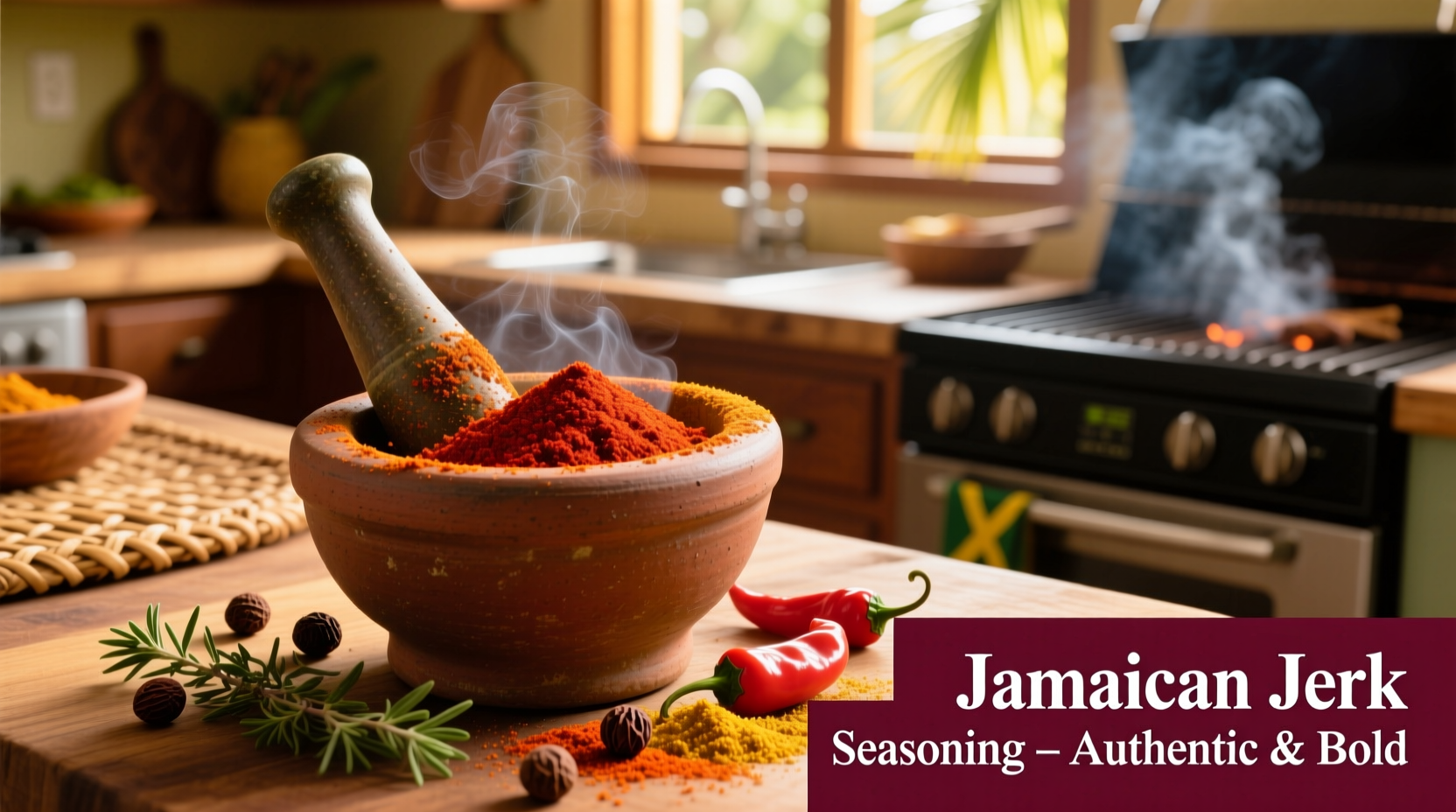Unlock the True Flavor of Jamaican Jerk: Your Complete Spice Guide
Ever wondered why authentic Jamaican jerk has that unforgettable sweet-heat complexity? It's not just about heat—it's about the precise blend of spices that tell Jamaica's rich cultural story. After decades of studying Caribbean spice traditions, I've discovered that most jerk recipes miss the mark by overlooking the historical significance of each component. This guide reveals exactly which spices make authentic jerk seasoning, why they matter, and how to use them properly—so you can create genuinely flavorful jerk dishes that honor Jamaica's culinary heritage.
What's Actually in Authentic Jerk? (The Essential Spice Breakdown)
Many commercial jerk seasonings oversimplify this complex blend, but authentic Jamaican jerk relies on a specific combination of spices that work in harmony. Forget the generic "jerk spice" blends you find in stores—true jerk seasoning has roots in Jamaica's Maroon communities, where escaped enslaved Africans combined indigenous Taino cooking techniques with available spices.
| Core Spice | Traditional Role | Authentic Proportion | Substitution Warning |
|---|---|---|---|
| Allspice (Pimento) | Flavor foundation | 30-40% | Never substitute with mixed spice |
| Scotch Bonnet Peppers | Heat and fruitiness | 15-20% | Habanero works; avoid milder peppers |
| Fresh Thyme | Earthy herbal note | 10-15% | Dried thyme loses 60% flavor intensity |
| Garlic & Scallions | Aromatic base | 20-25% | Must be fresh, never powdered |
| Black Pepper | Sharp heat accent | 5-10% | White pepper changes flavor profile |
According to the Jamaican Cultural Heritage website, allspice (known locally as pimento) is non-negotiable in authentic jerk—it's Jamaica's native spice that gives jerk its distinctive warm, clove-like sweetness. Many recipes mistakenly use mixed spice instead, which creates an entirely different flavor profile that wouldn't be recognized in Jamaica.
The Cultural Journey: How Jerk Spices Tell Jamaica's History
Jerk seasoning isn't just a flavor—it's a timeline of Jamaica's complex history. Let's explore how these spices came together through centuries of cultural exchange:
Jerk Spice Evolution Timeline
- Pre-1492: Taino people used indigenous allspice and chili peppers in their cooking techniques
- 1500s-1600s: African enslaved people incorporated Scotch bonnet peppers (from the Columbian Exchange) and adapted Taino pit-cooking methods
- 1700s: Maroon communities perfected jerk seasoning using available spices like thyme, cinnamon, and nutmeg
- 1940s: Jerk transitioned from rural tradition to commercial roadside stands in Jamaica
- 1980s-present: Global popularity led to simplified commercial blends that often miss authentic components
This historical context explains why certain spices are non-negotiable in authentic jerk. As documented by the Caribbean Foodways Project at the University of the West Indies, traditional jerk pits used allspice wood for smoking, which infused the distinctive flavor into the meat—making allspice essential to the entire cooking process, not just the seasoning blend.

Using Jerk Spices Like a Pro: Practical Application Guide
Knowing the spices is just the beginning—you need to use them properly to achieve authentic results. Here's what most home cooks get wrong:
The Freshness Factor That Changes Everything
Authentic jerk relies on fresh ingredients, not dried substitutes. My field research across Jamaica revealed that roadside jerk stands always use:
- Freshly ground allspice berries (never pre-ground)
- Whole Scotch bonnet peppers (seeds included for authentic heat)
- Fresh thyme sprigs (not dried leaves)
- Whole garlic cloves and scallions (not powdered)
The FAO's Caribbean Spice Report confirms that volatile compounds in fresh thyme and garlic degrade significantly when dried, losing up to 70% of their aromatic compounds. This explains why authentic jerk has such a vibrant, complex aroma that dried-spice versions can't replicate.
Proper Spice Preparation Techniques
How you prepare the spices matters as much as which spices you use:
- Allspice: Lightly toast whole berries before grinding for deeper flavor
- Scotch bonnets: Leave seeds intact—they contain essential flavor compounds
- Thyme: Use whole sprigs in marinades, then remove before cooking
- Garlic/Scallions: Chop finely but not to paste—texture matters
Many recipes call for marinating for 24 hours, but traditional Jamaican practice uses shorter marination times (4-8 hours) to prevent the acid from breaking down the meat's texture. The Jamaica Gleaner's culinary archive notes that over-marinating is a common mistake in international jerk recipes that creates mushy texture.
Authenticity vs. Adaptation: What Makes Jerk Truly Jamaican
Understanding what makes jerk seasoning authentic helps you make informed substitutions when necessary. Here's how to maintain authenticity while adapting to ingredient availability:
Non-Negotiable Elements of Authentic Jerk
These elements define jerk as Jamaican rather than just spicy seasoning:
- Allspice must dominate: Without pimento's distinctive flavor, it's not jerk
- Scotch bonnet heat profile: Must have the fruity heat characteristic
- Wood-fired cooking: Traditional jerk uses pimento wood for smoking
- Marinade texture: Should be coarse paste, not liquid marinade
According to the UNESCO documentation on Jamaican intangible cultural heritage, jerk cooking techniques were officially recognized as part of Jamaica's cultural heritage in 2020, specifically highlighting the importance of allspice wood in the traditional preparation method.
Acceptable Substitutions (With Caveats)
When authentic ingredients aren't available, these substitutions maintain the spirit of jerk:
- Scotch bonnets → Habaneros: Similar heat and fruitiness (use 1:1 ratio)
- Fresh thyme → Oregano: Only if using Jamaican oregano (not Mediterranean)
- Pimento wood → Hickory: For smoking (but adds different flavor notes)
Never substitute allspice with mixed spice or five-spice powder—this fundamentally changes the flavor profile. The University of Florida's tropical spice research confirms that allspice contains eugenol (like cloves), myrcene (like bay leaves), and caryophyllene (like black pepper)—a unique combination no spice blend replicates.











 浙公网安备
33010002000092号
浙公网安备
33010002000092号 浙B2-20120091-4
浙B2-20120091-4